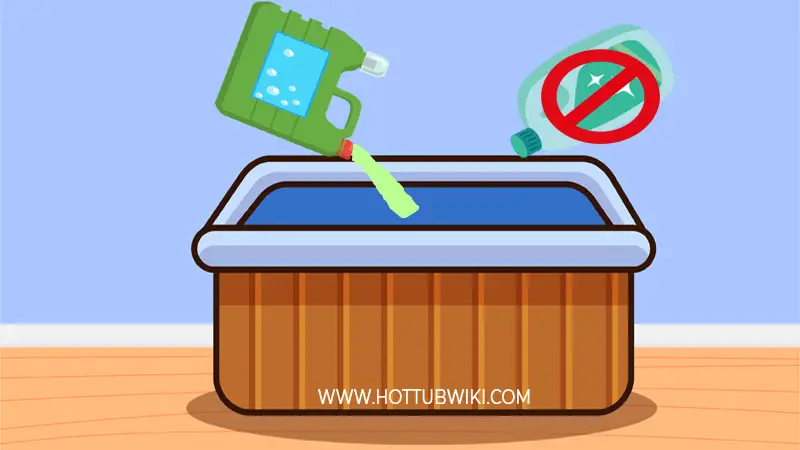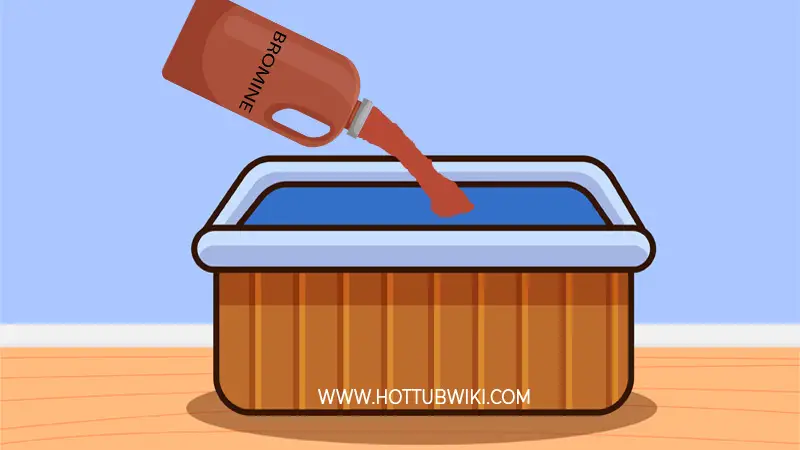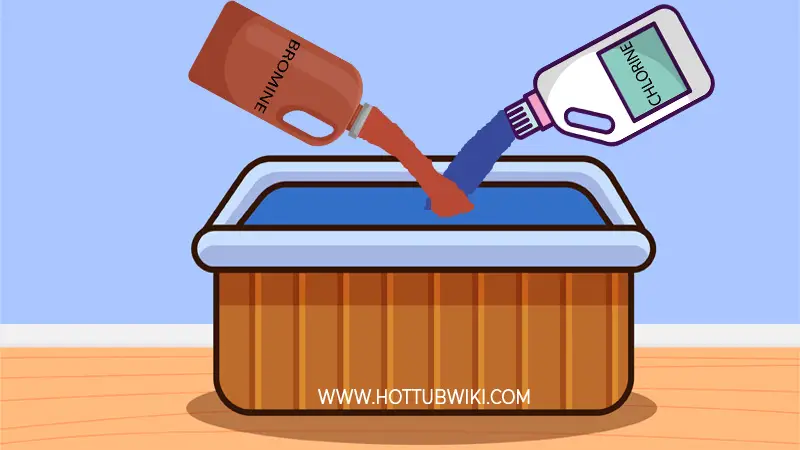Chlorine and bromine are the most common sanitizers used to clean hot tub water. Both sanitizers combat germs and scum in the hot tub to make the water clean and safe but these sanitizers can’t do all the work. But, can you use chlorine shock in a bromine spa? Here’s the answer:
Yes, you can use chlorine shock in a hot tub even if you use bromine as the regular sanitizer for that hot tub. Using chlorine shock in a bromine hot tub wouldn’t harm your hot tub and it would not produce any toxic fumes.
Chlorine shock will reactivate the bromamine in your bromine hot tub, thereby making the bromine more effective in dealing with contaminants in the hot tub water. But that’s just a quick snapshot. Keep reading to find out more about using chlorine shock in a bromine hot tub.
Can I Mix Chlorine and Bromine in a Hot Tub?
You can mix chlorine and bromine sanitizers in a hot tub because both sanitizers are used to make the hot tub water clean and healthy. Many hot tub shock products contain chlorine and they are used in bromine hot tubs. This means you can mix chlorine and bromine sanitizers in your hot tub without experiencing any dangerous side effects.
But, there are a few things to consider first:
For starters, chlorine and bromine should never be mixed in their dry state or powdery form. Doing this can create a dangerous chemical reaction. This is because both sanitizers in their dry state are very potent and unprocessed. Mixing them can cause the chemicals to become unstable.
Also, adding chlorine to a bromine hot tub will only create more bromine. When you add chlorine to a bromine hot tub, the bromide ions will react by converting the chlorine that you added into free bromine. This is why it’s fine to use chlorine shock in a bromine hot tub.
The chlorine you added either as a sanitizer or as a shock does not raise the chlorine levels in the water. The chlorine shock will reactivate the bromine in the water, increase the free bromine level and make the bromine more effective. The reverse is the case if you mix chlorine and bromine in a chlorine hot tub.
If you add bromine to a chlorine hot tub, you wouldn’t get more chlorine and the bromine you added wouldn’t do much either. The bromine you added to the chlorine hot tub wouldn’t be used up over time. Instead, the bromine will build up in the chlorine hot tub and cause a heightened chlorine demand in the water.
So while it is safe to add chlorine to a bromine hot tub, it’s not ideal to add bromine to a chlorine hot tub.
[amazon fields=”B08QNJ34X2″ button_text=”Check Amazon Price” value=”button”]
[amazon box=”B08QNJ34X2″]
How Often Should You Shock a Bromine Hot Tub?
A bromine hot tub should be shocked every week because the bromine used as the sanitizer is not very effective in getting rid of mold, algae, and bacteria.
This means that while the bromine will keep your water clean for a while, it can only do so much before the hot tub is affected by a nasty case of algae bloom or bacteria attack.
You need to shock the hot tub once every week preferably with chlorine shock so there isn’t any possibility for the hot tub to be affected by algae and bacteria.
Bromine is an effective sanitizer. It cleans the water very well and can also maintain a steady pH level for a long time. It is also gentle on the skin and doesn’t release any offensive odor. But it has a big disadvantage.
Bromine is not very effective in killing hot tub germs. Bromine can only kill the basic bacteria and algae. This causes a build-up of bacteria and algae over time. So you need to shock the hot tub every week to prevent a build-up of germs and to release more bromamine in the water.
Can the Wrong Chemicals Damage My Hot Tub?

Yes, the wrong chemicals will very much damage your hot tub. Wrong chemicals include expired chemicals and cheap chemicals. Using wrong chemicals on your hot tub shell or in the hot tub water will shorten the lifespan of your hot tub by causing corrosion, staining, foaming in the water, and so on.
Wrong chemicals like undiluted bleach can increase the acidic content of your hot tub water by dropping the pH levels of the water. Hot tub water with a high acidic level will damage and corrode several parts of your hot tub. The acidic water will start to eat away at the metal parts of the hot tub like the jets, the circulation pump, and the heater. It can also cause these parts to malfunction.
Wrong chemicals can also cause stains on the hot tub shell. These chemicals will cause a brown or yellow tint to appear on the surface of the water and this brown tint will cause stains on the shell of the hot tub. These stains are more noticeable right where the water line forms in your hot tub. The stains can also appear below the waterline.
The wrong chemicals can also cause foaming in the hot tub. Foaming occurs when the water chemistry is off and the water chemistry can be altered if you add the wrong chemicals to the hot tub. Once the water chemistry is altered, foam starts to form on the water surface. Unbalanced water chemistry can also make the water very cloudy and unclear.
Can You Shock a Chlorine Hot Tub With Bromine?

No, you can’t shock a chlorine hot tub with bromine. Bromine cannot be used to shock a hot tub regardless of if it’s a chlorine hot tub or not. This is because bromine is not an oxidizer. Bromine is just a sanitizer and since hot tub shocks have to be able to oxidize the water, bromine can’t be used as a shock.
Bromine is used as a regular sanitizer for hot tubs and it’s more common with hot tub owners that have sensitive skins. This is because bromine sanitizer is not as potent as chlorine. It is more suitable for keeping the water chemistry balanced for a long time.
Bromine isn’t powerful enough to be used as a hot tub shock. Regardless of if you have a chlorine hot tub or a bromine hot tub, the bottom line is bromine isn’t an oxidizing chemical and that means it is not a hot tub shock.
That being said, the only shock that should be used in a chlorine hot tub is a chlorine shock. Bromine is never the way to go.
Related Read >>> How To Lower Chlorine or Bromine Levels in a Hot Tub?
What Is the Difference Between Chlorine and Non-chlorine Shock?
The main difference between chlorine shock and non-chlorine shock is that chlorine shock is more potent than non-chlorine shock.
Chlorine shock can be used in any hot tub but the non-chlorine shock is ideal for bromine spas or hot tub owners that can’t cope with the intense nature of chlorine. But that’s not all. Let’s check out some other differences.
Which Shock Dissolves Faster?
Chlorine shock dissolves in the water quicker than non-chlorine shock. The particles of chlorine shock make it very water-soluble. This also means it gets to work faster than non-chlorine shock since non-chlorine shock takes a longer time to dissolve and kick off in your water.
The Use
Chlorine hot tub shock is suitable for all hot tubs regardless of which sanitizer you use in the hot tub. Chlorine shock will work well in a chlorine hot tub and a bromine hot tub. The formula of the chlorine shock contains chemicals that will help to reactivate the chloramines or bromamines in the hot tub.
The chlorine shock will help to increase the free sanitizer level in the water making it possible to kill and get rid of algae bloom or bacteria growth. The non-chlorine shock on the other hand is more suited to bromine hot tubs.
Potency
Chlorine shock is very effective in killing germs. Bacteria, algae, mold, fungus, and other microorganisms do not stand a chance with chlorine shock. The non-chlorine shock will also kill germs in the hot tub but it is limited.
Non-chlorine shock can’t deal with extreme cases of bacteria or algae growth. This makes it limited in its effectiveness. Non-chlorine shock can also lead to cloudy spa water which is one of the many problems a good shock should correct.
However, if you want a mild hot tub shock, non-chlorine shock is the way to go. Non-chlorine shock is not as active as chlorine shock. It also doesn’t give off offensive smells after you add it to the water, unlike chlorine shock.
Non-chlorine shock also makes it possible to use the hot tub a few minutes after shocking the water. Chlorine hot tubs on the other hand will require at least a few hours after using it before you can use the hot tub.
The Cost
If cost is your concern, then you’ll be happy to know that chlorine shock usually comes cheaper than non-chlorine shock. This should t come as a shock though seeing as bromine sanitizer is also more expensive than chlorine sanitizer.
It seems in this world, the cheaper chemicals or sanitizers are the most expensive but be very careful of the type of chemicals you buy. Some cheap chemicals will damage your hot tub and cause you to spend way more on repairing the hot tub than you would have to buy the right chemical in the first place.
Final Words
Overall, chlorine shock can be used with any hot tub regardless of the type of sanitizer you were using in the hot tub before. In a chlorine hot tub, the chlorine shock will complement the efforts of the chlorine in the hot tub and it will kill the germs and contaminants in the water.
In a bromine hot tub, the bromide ions will turn the chlorine shock into free bromine which in turn gets rid of the germs and contaminants in the water.
However, if you are worried about the smell of the chlorine shock, you can always buy a non-chlorine shock. Just know that it might not be as effective in getting rid of germs like a chlorine shock.

